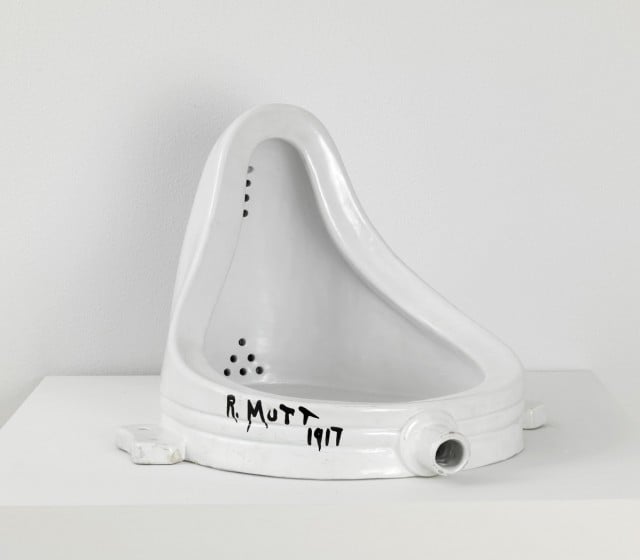
With my current Koons obsession (there’s more to come of that) it’s no wonder that I can’t stop thinking about Marcel Duchamp’s readymades. And wouldn’t you know it, just when the Koons retrospective is up at the Whitney, barely up the street from it at Gagosian Gallery we can take in a lovely little survey of Duchamp’s editioned works from the 1960s–of which this, of course, is Fountain, from 1964.
Except this Fountain is not a readymade, by any stretch. A readymade is, by definition, a found or purchased object that is normally used to fulfill some mundane function, and is then repurposed by an artist to count as art. Duchamp’s 1964 piece is not that at all: It is a hand-crafted, editioned, gallery-sanctioned, sort-of-signed simulation of the functional urinal that Duchamp bought and showed as art in 1917. (There’s a theory out there that even the 1917 urinal was originally a one-off ceramic sculpture, but I don’t buy it .)
That is, the 1964 object is essentially a perfectly normal work of art that should be classed as part of the ancient high realist tradition: It presents the illusion of some other object that was once in the world. It could even count as one of the last great flourishes in the grand tradition of trompe-l’oeil. (Note that Koons’s remade readymades are another thing altogether: They imperceptibly replace his original purchased vinyl flowers, thus underlining the fact that his pieces are about the qualities of the objects themselves, not about the gesture of presenting them as art.)
The camera that took today’s photo is almost positioned to focus on a crucial giveaway detail in the 1964 Fountain: the ceramic tube that, in the 1917 version, would have been attached to a water supply but that in this edition could never be plumbed, because it is partly blocked with clay.
The fact that the 1964 Fountain is not a readymade is no knock against it, or Duchamp. As I’ve said before, it shows Duchamp smartly realizing that to remake his lost work from 1917, just because some unusually dumb collectors wished they could own it, would have been an absurdity–an impossibility, almost. (He had earlier told some Fountain-hungry collectors to go out and buy their own urinals, but that wouldn’t have given them a Duchamp; they would have ended up with their own weak derivations from his original gesture.) In 1964, Duchamp decided to turn out a brand-new, editioned, fine-art sculpture that commented on how art circulates in the world, just as the 1917 readymade did, while also adding a satiric, sardonic comment about the folly of collectors and the art market.
I like to think that, when Andy Warhol traded one of his portraits for one of Duchamp’s high-realist Fountains, sometime after 1974, that dedicated Duchampian and master of commodity culture knew precisely what he was getting. (©Succession Marcel Duchamp / ADAGP, Paris / Artists Rights Society (ARS), New York 2014; photo by Robert McKeever)
For a full survey of past Daily Pics visit blakegopnik.com/archive